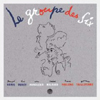Le Groupe des Six, "Selected Works 1915-1945 (Vol. 1)"
 An extensive double disc collection documenting the output of six French tutees of Erik Satie and Jean Cocteau, this album is a near necessity in any cohesive understanding of France's musical environment in the interim between World Wars. Comprised of Georges Auric, Louis Durey, Arthur Honegger, Germaine Tailleferre, Darius Milhaud and Francis Poulenc, "Les Six" forged an approach generally marked by spare concision, a response to the flowery output of the Romantic and Impressionist tendencies of composers such as Wagner and Debussy.
An extensive double disc collection documenting the output of six French tutees of Erik Satie and Jean Cocteau, this album is a near necessity in any cohesive understanding of France's musical environment in the interim between World Wars. Comprised of Georges Auric, Louis Durey, Arthur Honegger, Germaine Tailleferre, Darius Milhaud and Francis Poulenc, "Les Six" forged an approach generally marked by spare concision, a response to the flowery output of the Romantic and Impressionist tendencies of composers such as Wagner and Debussy.
Their response, as is suggested in the relatively brief but informative liner notes, was closely linked to their teachers' approaches. The first disc, which mostly presents a series of miniatures from the group, displays an overarching tendency toward the kind of spatial melodicism for which Satie was a major proponent. Auric's "Prelude" opens the disc with a small and whimsical piano work who's dainty moves are at once simple and intricately emotive.
This approach would garner much attention and, though many of these musicians would not be heard from in a wider circle, the Parisian associations are unavoidable when listening to any of this material. In fact, so singular is the sound that one piece flows into the next as if they were written as such, with the second track, Durey's "Romance sans paroles," flowing perfectly from the first with an even more uncluttered sound.
This neo-classical approach is largely best exemplified by the piano pieces, which take up the majority of the first disc, as these allow for the clearest grasp on the work. Milhaud, perhaps the best known of the six people featured here, is marked by a fluidity on "Caramel mou" that moves from mood to mood at a moment's notice without ever losing sight of a certain bar room pulse and energy. Poulenc's gentle "Huit nocturnes" flit atmospherically about with little pretension and a careful respect for each note. With such being the case, it is perhaps inevitable that many of these pieces are infused with an admiration for the silences between each note, infusing each piece with an almost reverential simplicity of cause.
In stark contrast to the first disc's 22 pieces, the second presents only three. Milhaud's "La Création Du Monde" is a ballet whose playful genre-jumps are in marked proximity to the cartoon music of Stalling and Golden Era Hollywood soundtracking as well as the jazz and Brazilian music Milhaud had been studying. Conversely, Honegger's "Prélude, Fugue Et Postlude" is a dramatic and radiant work whose reach is similarly expansive, though perhaps a bit more serious in intention. Yet the bulk of the disc is taken up by the nearly hour-long "Les Mamelles De Tirésias" of Poulenc. Again almost cartoonish in nature, the two-act opera bouffe is nevertheless a vast demonstration of the creativity and broad reach of the composer at hand.
A fine and well-compiled compilation, the discs here are filled with exciting and highly varying approaches to a certain style at a certain time. That many of these works are difficult to acquire in another context only makes the album more intriguing. Though this may seem an oddity among the 20th century classical canon, this is highly enjoyable, interesting music whose renown is perhaps not what it should be considering its quality.
samples:



